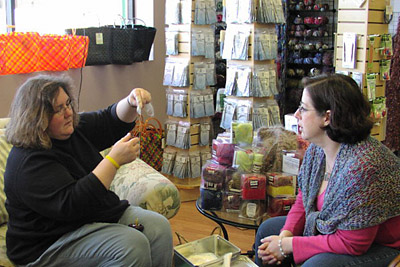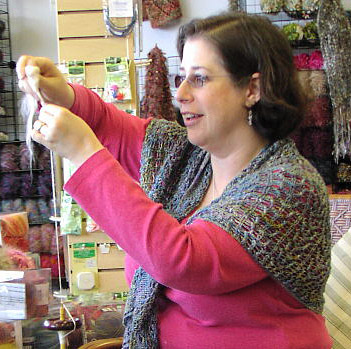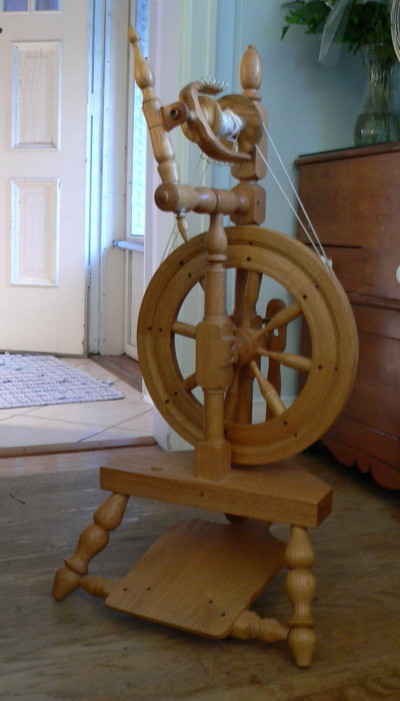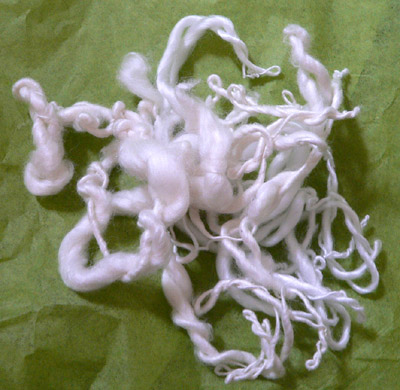And so it is with
spinning, but with a twist. Pun intended.
About a year ago,
I started seeing blogger-friends write
about their adventures in spinning.
Most with spindles, but some with
wheels. None of them spun anything
but wool. Where did that leave wool-allergic
me? Actually, I soon realized, it
left me in a really interesting place.
Ask anyone who's
a spinner and I expect each one will
tell you what I've already heard:
nothing is as easy to spin as wool.
But just how hard IS it to spin something
else? Cotton. Silk. Soy silk. Ingeo.
Is it like trying to capture a firefly
in a thimble -- so frustrating that
it's not worth the effort? Or is it
just different?
I chose to believe
the latter and started on a path to
learn to spin. After all, how can
anything be harder than something
you can't even try?
When
I learn something new, I read
the book AFTER I've tried the
thing a few times. I find the
doing helps me get the concepts
in my head as concepts, and
then the reading from the book
helps label them and fix them
in my head.
|
I started with my
associates at Interweave
Press. They are the source of,
arguably, the best spinning reference
books currently available. The legendary
Alden Amos Big Book of Handspinning,
by Alden Amos is one of theirs,
as is the book most people pointed
me to to learn what I needed to get
started: Hands on Spinning,
by Lee Raven.
I also got a small
stash of undyed spinning fiber to
practise with in Soy silk and Ingeo,
from South
West Trading Company, and some
silk and a small bag of a cotton/lyocell
blend from Dreamspin
Fibres.
To spin on, a wheel,
maybe? Um, no. I thought I'd start
small instead: two spindles from The
Bellwether, chosen on the advice
of the proprietress, Amelia Carlson.
A Tabachek Compact Deluxe and a St.
Helen's from Cascade. Two different
weights to spin silky stuff of different
thicknesses, she said. Plus they were
very pretty. I'm a Gear Ho™.
It's all about the pretty with me.
I was ready to go.

 My
first lesson took place last fall
in the comfy chairs at Threadbear
Fiber Arts in East Lansing, Michigan.
My friend Carla, an experienced spinner,
had offered to teach me, so she got
the spindle started with some Soy
silk.
My
first lesson took place last fall
in the comfy chairs at Threadbear
Fiber Arts in East Lansing, Michigan.
My friend Carla, an experienced spinner,
had offered to teach me, so she got
the spindle started with some Soy
silk.
Carla demonstrated
what I was to do, her skilled fingers
pinching the twist to control it.
She gently pulled her fingers up,
allowing the twist to travel into
a small section of the drafted fiber,
and it became yarn. Yarn!
She stopped, wound
the new yarn onto the spindle, and
continued spinning. It was beautiful.
Then it was my turn.
What happened next
was not pretty. I liked spinning the
pretty wooden spindle, and watching
it turn. However, my hands didn't
quite get what they were supposed
to do and I watched helplessly as
the twist migrated into the big mass
of fibers in my right hand, making
cat barf out of what had been perfectly
good fiber just moments before.

 I
was not encouraged. But in teaching
people to knit over the last few years,
I also know the student's natural
urge to apologize for their lack of
skill and was determined not to do
that. I have a LONG way to go and
a lot to learn, and I figured it'd
be better to just get back to work.
I
was not encouraged. But in teaching
people to knit over the last few years,
I also know the student's natural
urge to apologize for their lack of
skill and was determined not to do
that. I have a LONG way to go and
a lot to learn, and I figured it'd
be better to just get back to work.
I asked Carla to
show me again. She did, over and over,
and still, I didn't get it. Okay,
that's not true. I got some of it.
It reminded me of learning to drive
a car. Turning the wheel is not hard.
Applying the brake is not hard. Watching
what's happening in front of you is
not hard. But put those three together
with watching behind you, checking
intersections as you pass to make
sure you're not gonna get t-boned
and every other tiny thing experienced
drivers do without thinking...and
it's really overwhelming. That's what
spinning felt like to me. I could
spin the spindle. I could pinch the
fiber. I could draw my fingers down
and apply some twist. But man, you
should have seen the mess I made when
I tried to do it all.
After about an hour,
I'd had enough. I put my fiber and
spindles into my Knitty lunchbox and
thanked Carla for the lesson. Then
I bought some yarn and went home.
So where did this
leave me? I wasn't feeling empowered
in the least...like if I just kept
trying, it would come. Spinning felt
completely out of my reach.
That's when my friend
Jillian reminded me she never liked
spindle spinning and found it much
harder than spinning on a wheel. But
a spindle costs around $30. A wheel
is more than 10 times that, at the
very least. A big expense for something
I might not even like doing. And then
came the offer -- she would lend me
her small Reeves castle wheel indefinitely,
so I could practise and learn to spin
that way. She had another wheel and
wouldn't miss the Reeves for a while
and really it was okay.

 How
could I say no to such a generous
offer? I didn't. I said thank you
and neatly stashed the wheel in a
dry part of the basement where it
would come to no harm from out-of-control
vacuum cleaners or a stray rabbit
with itchy teeth.
How
could I say no to such a generous
offer? I didn't. I said thank you
and neatly stashed the wheel in a
dry part of the basement where it
would come to no harm from out-of-control
vacuum cleaners or a stray rabbit
with itchy teeth.
And it sat there
for 8 months. It scared me.
This past spring,
my husband and I stumbled across a
spinning show and sale just north
of the city. In the center of the
hall, a woman sat at her Louet double-treadle
wheel, spinning wool in what looked
like the most relaxed, effortless
way possible. The yarn she spun was
perfectly even, every inch the same
thickness as the inch before and after
it. The light caught it. It gleamed.
I wanted. I watched her for a while.
Asked questions. Was again told how
much harder cotton and silk would
be to spin. And when I left, I knew
I was finally going to give it a shot
this time.
Again, I came up
against the wall of wool. Though we
have four new yarn shops in my big
city, we have none that specialize
in spinning. One of the old standby
yarn shops offers fiber and lessons,
but again -- with wool. The spinning
guild meets during the day on Mondays.
No good for me. I've got a day job.
So I hit the net
and found Ms X*. Her business is in
supplying and custom-blending fibers
for spinning, not spinning lessons,
but I was getting desperate already.
Because she carried cotton and silk
fiber, I thought it was worth a shot,
so I asked if she'd teach me. She
said she would be happy to.
People are nice.
I headed up to her
house with my borrowed Reeves, my
spindles, a few bags of whatever fiber
I had on hand already and a positive
attitude. Ms X welcomed me into her
home, showed me her huge drum carder
[way cool] and studio lined with translucent
plastic tubs filled with fiber of
all descriptions.
 |
My
very own handspun cat barf.
Nowhere to go but up.
Content: cotton/lyocell [aka
Tencel] |
 She
set up the Reeves, taking the two
drive bands and putting them where
they needed to be, pulled out some
Ingeo from her stash and got it started.
She got the wheel rotating, treadling
in an even, smooth rhythm. The Ingeo
turned from looking like the kind
of fluff you'd clean your ears with
into shimmery silky yarn that the
bobbin quietly sucked onto itself.
Oooh. My turn.
She
set up the Reeves, taking the two
drive bands and putting them where
they needed to be, pulled out some
Ingeo from her stash and got it started.
She got the wheel rotating, treadling
in an even, smooth rhythm. The Ingeo
turned from looking like the kind
of fluff you'd clean your ears with
into shimmery silky yarn that the
bobbin quietly sucked onto itself.
Oooh. My turn.
Instead of the instant
frustration I felt with the spindle,
I felt instant possibility. I could
only make little inconsistent messes,
but now I could see how the fiber
was supposed to behave and maybe a
little of how I'd get there.
Over and over again,
I started the wheel, spun a little
and watched the thick/thin/halfspun/
overtwisted/perfect quarter inch/big
sloppy slub/so fine it could break
if you breathed on it/yarn move through
my fingers. Nothing I did matched
anything I did the next moment, but
it felt good. Every time I got a good
quarter inch, I felt elated and then
immediately lost whatever rhythm I'd
discovered. No matter. I just kept
going.
I'm going to keep
going.
* I'm calling
her Ms. X because she doesn't want
to give lessons. She too has a day
job in addition to her fiber business,
and what little spare time she has
she wants to be able to focus on her
business. That's cool.

